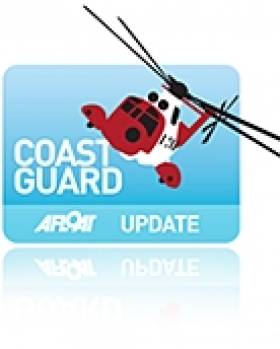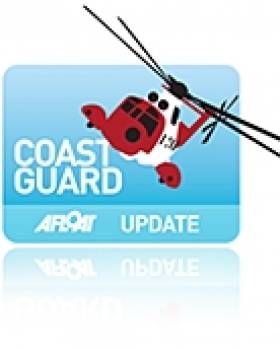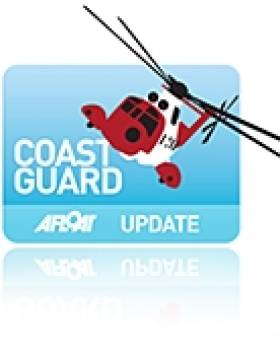Displaying items by tag: Search and Rescue
#News - UTV News reports that a body recovered from the River Foyle on Thursday 9 May is that of missing Dublin teenager Kieran McKeon.
The 18-year-old was reported missing two months ago along with a friend, 21-year-old Alexandra O'Brien, whose body was found in the water close to Foyle Bridge in Derry on 14 March, as previously reported on Afloat.ie.
It's thought that the two took their own lives in a suicide pact, after eyewitness reports described two people falling into the river from the bridge.
Personal items said to belong to O'Brien and McKeon were found on the bridge which sparked off the search operation led by Foyle Search and Rescue, which had continued every evening since at low tide, with a full search once a week.
UTV News has more on the story HERE.
#Coastguard - The Irish Coast Guard may lead open-sea searches for American space bosses when manned space flights resume, according to the Irish Examiner.
Coastguard chiefs have reportedly been in informal discussions with a senior official from Nasa regarding search and rescue procedures should a manned capsule come down in the North Atlantic.
Nasa's planned launch trajectory for rockets to the ISS or the moon, scheduled to resume in 2016, passes the south coast of Ireland within range of the new Shannon-based helicopter Rescue 115.
This means that if a Nasa vehicle were to ditch in those waters, the Irish Coast Guard would take the lead in any search and rescue effort.
The Irish Examiner has much more on the story HERE.
Sligo Coastguard Chopper In Rescue Of 'Idiotic' Climbers
#Coastguard - A Limavady councillor says two men rescued yesterday from the snow-covered Benevenagh Mountain should be billed for the cost of their "completely idiotic" escapade.
The Belfast Telegraph reports that the Irish Coast Guard's Sligo-based Rescue 118 helicopter was involved in the major operation to retrieve the two men who became stuck while climbing a snow gully.
It also emerged that a PSNI search and rescue team had to be airlifted to the site by an Army Air Corps helicopter that had been involved in distributing animal food relief to farmers badly affected by the recent poor weather.
Limavady councillor Edwin Stevenson, who is also a farmer, said: "I am at an absolute loss as to why anyone would decide to climb Benevenagh in these conditions and can only describe the actions of these two men as completely idiotic."
He suggested that the NI Executive should consider "billing people who carelessly risk not just their own lives, but also the lives of the emergency services who invariably end up having to dedicate time and energy rescuing them".
The Belfast Telegraph has more on the story HERE.
Search for Missing Spanish Fisherman Off Southwest
#Coastguard - The Irish Coast Guard's Rescue 115 helicopter was tasked overnight to search for a missing Spanish fisherman who fell overboard from his fishing trawler off the southwest coast in the early hours of this morning.
98FM is reporting the latest news on this incident, saying that the man went into the sea some 25 miles off Mizen Head.
The alarm was raised around 4am and the coastguard station at Valentia is co-ordinating the search and rescue effort, with RNLI lifeboats from Baltimore and Castletownbere in West Cork assisting.
RNLI Answers More Than 400 Calls in NI in 2012
#RNLI - Lifeboats in Northern Ireland launched 255 times to a variety of call-outs in 2012 in a year that saw the institution's lifeboats and lifeguards answer 413 calls for help.
RNLI search and rescue operations saw 236 people brought safely to shore throughout the year by the nine volunteer lifeboat crews located across the region.
The annual statistics released by the charity today (22 January) show that of the figures, 111 services took place in darkness while crews collectively spent 2,193 service hours at sea.
Bangor was the busiest lifeboat station in Northern Ireland last year, launching to 53 requests for help with the crew rescuing 53 people off the Co Down coast.
Enniskillen, which operates two bases on Upper and Lower Lough Erne in Co Fermanagh and which is the North’s only inland RNLI station, launched 46 times and brought 50 people to safety.
Meanwhile, Portrush RNLI in Co Antrim launched 33 times and rescued 33 people.
It was also a busy year for the 10 RNLI lifeguard units located on beaches in Co Down and along the Causeway Coast, where lifeguards responded to 158 incidents and assisted 176 people who found themselves in difficulty.
The Causeway Coast, where there are seven units located, was the busiest area, with Portrush East lifeguards responding to 31 incidents and assisting 35 people. The Benone unit attended 30 incidents and assisted 30 people while the Portrush West unit responded to 25 incidents and assisted 32 people.
Overall in Ireland, RNLI lifeboats launched 939 times with the volunteer crews across the 44 stations rescuing 1,041 people. Dun Laoghaire was the busiest lifeboat station in the Republic in 2012, responding to 46 call-outs throughout the year and rescuing 76 people.
Commenting on the 2012 statistics for Northern Ireland, RNLI operations manager Martyn Smith said: "The RNLI lifeguard service has expanded to 10 beaches in Northern Ireland and with the support of the local authorities they have an active and welcome presence on many beaches.
"They do not just saves lives and assist those in trouble in the sea, but also provide information, advice and first aid when needed, ensuring many potential incidents are prevented.
"I would like to say a huge thank-you to all those who support the RNLI, a charity dependent on the generosity of the public, whether by giving up their time or by making a donation."
Lough Ree Locals Praise New RNLI Lifeboat Station
#Lifeboats - RTÉ News has a video report on a memorial to lives lost on the Shannon recently installed at the location of Lough Ree's new lifeboat station.
Relatives of those lost to the waterway spoke of their appreciation for the setting up of the new search and rescue base for the mid-Shannon after a decade of campaigning.
As reported on Afloat.ie last July, the RNLI's 44th lifeboat station in Ireland - located at Coosan Point in Athlone - Co Westmeath, has been welcomed as a search and rescue asset on Lough Ree and the Shannon.
Some €150,000 has been invested in the temporary facilities, from which volunteers operate the B class Atlantic 75 lifeboat Dorothy Mary, on a year-long trial basis.
According to RNLI Lough Ree's Matt Harte, the new station was among the busiest in Ireland last year, with up to 20 call-outs in its six months of operation thus far.
Howth Coast Guard Reviews A Busy 2012
#Coastguard - Howth Coast Guard responded to 53 calls throughout 2012, with its 25 volunteers clocking up more than 4,000 man hours.
In its review of the year, the north Dublin unit of the Irish Coast Guard noted that while its safety boat Grainne was dispatched to fewer calls on the water, there was an increased number of cliff and beach incidents to attend to, particularly in the Clontarf and Dollymount areas.
Howth also became one of the first search and rescue teams in the State to avail of the Irish Coast Guard's new side scan sonar.
As previously reported on Afloat.ie, the coastguard saved 161 lives throughout a busy 2012 that saw the network respond to almost 2,000 call-outs nationwide.
And 2013 so far has been off to a busy start, marked by a dramatic cliffside rescue in Donegal on New Year's Day.
Dramatic Donegal Rescue Marks Busy Start to 2012 for Coastguard
#Coastguard - The Irish Coast Guard has had a busy first few days of the New Year with a number of incidents around the country, including a dramatic search and rescue incident in Donegal.
Carlow man Cormac Nolan was rescued after falling 200 feet and becoming trapped in a crevasse while walking on the Slieve League cliffs on the north west coast of Donegal on Tuesday 1 January.
The cliffs are among the highest sea cliffs in Europe, and combined with the man's precarious position and the weather conditions at the time, the Sligo-based Irish Coast Guard helicopter was unable to winch the man to safety despite its swift response.
The operation - assisted by the Killybegs coastguard unit, Donegal Mountain Rescue and the Aranmore RNLI lifeboat – proceeded to a cliff descent which itself was hampered due to shingle on the cliffside.
Search teams eventually reached the casualty after 10:30pm and began the slow process of bringing him back up the cliff, finally doing so around midnight.
The 28-year-old - who discussed his ordeal on RTÉ Radio's News at One this afternoon - was transported by coastguard helicopter to Sligo General Hospital but no serious injuries were reported.
The Donegal incident was just one of a number of search and rescue taskings received by the Irish Coast Guard over the New Year period, coming after news that the coastguard saved 161 lives last year.
Other incidents included searches for missing persons in Wicklow and Dublin and dispatches to reports of persons in the water in Waterford, Limerick and Louth.
Speaking yesterday, Irish Coast Guard director Chris Reynolds said: “Last year was the busiest ever for the Irish Coast Guard and already in the early days of 2013 we have provided assistance in a number of incidents.
"I am appealing again to the public that they heed local advice and be aware of weather conditions if walking or hiking along our coastline, particularly during winter time.”
Reynolds continued: “There is safety in numbers, so never be alone while walking along cliff paths if possible. Let somebody know when and where you are going and what time you will be back. Stay well away from the cliff edge, both top and bottom. Don’t attempt to rescue people or pets if they fall over the edge.
"If assistance is required dial 112 and ask for the coastguard. Advice as always from the coastguard is if you do see someone in difficulty in the sea, on the shore, cliffs, lakes or rivers, dial 999 or 112 and ask for the coastguard.”
Exclusive Footage of Tit Bonhomme Rescue on RTÉ
#MARITIME TV PROGRAMMES - Footage from the rescue of the only survivor of the Tit Bonhomme tragedy in West Cork last January will feature in the first of a new series of Ireland's Search and Rescue tomorrow evening on RTÉ One.
Abdul Mohammed, 43, survived the sinking of the trawler when it ran around in rough seas near Adam's Rock at Glandore Harbour, after he was able to reach the shore.
His brother Wael Mohammed (35) died along with skipper Michael Hayes (52), Saied Ali Edlin (26), Attea Shaban (26) and Kevin Kershaw (21) when the boat went down.
As the Southern Star reports, Mohammed will feature in Sunday's programme talking to presenter Claire Byrne about his struggle to survive the tragedy, while exclusive footage from the Irish Coast Guard's Rescue 117 helicopter, the Irish naval vessel LE Niamh and Naval Service divers shows the search for the missing fisherman in the wake of the incident - a first for Irish television.
The first episode of the six-part series will be broadcast this Sunday 18 November at 6.30pm on RTÉ One.
Coastguard Urges Proper Use of Emergency Locators After Midweek Incident
#COASTGUARD - The Irish Coast Guard has urged any sailors or aviators using emergency locator transmitters (ELTs) to take care with their use and storage after an incident last week, The Irish Times reports.
A major search and rescue operation was mounted after a signal from an aircraft emergency beacon was detected by the Valentia coastguard station and Shannon air traffic control on Wednesday night.
Two rescue helicopters and numerous ground crews were involved in the search for what was thought to be a crashed small aircraft before the beacon was found at the rear of a property on Thursday afternoon.
A spokesperson for the Irish Coast Guard said: “We would ask anyone who who has one of these devices to ensure it is properly stored and not allowed to decay.
"If the battery in one of these units dies or the device is allowed to short-circuit because of dampness, the ELT will activate."






































































